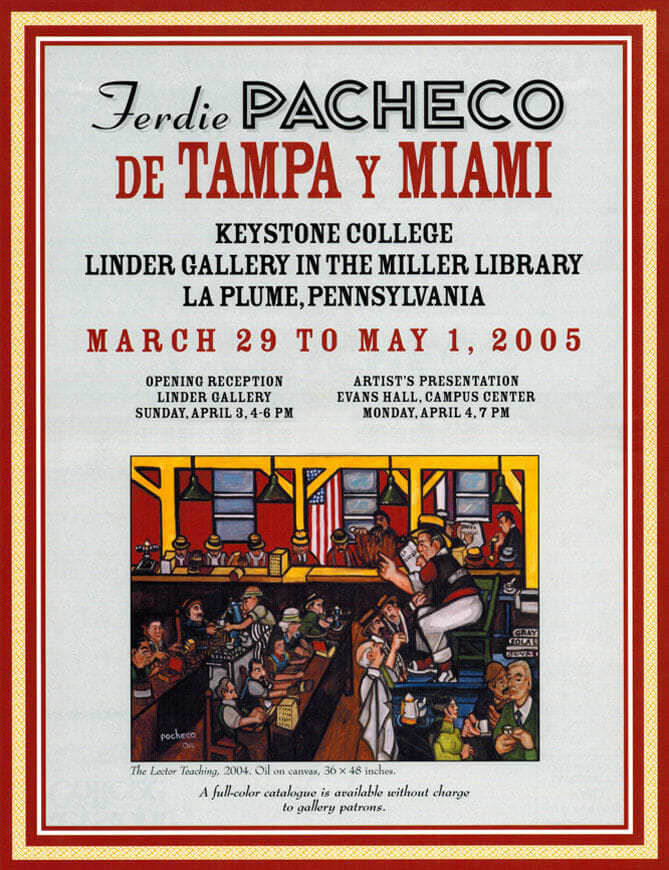Preface to the catalog for the exhibit Ferdie Pacheco: de Tampa y Miami. Held at the Linder Gallery, Keystone College, March 29-May 1, 2005.

Exhibitions often evolve through the strangest of circumstances, and this one is no exception. But the evolution of Ferdie Pacheco: de Tampa y Miami was not only serendipitous, but long and winding, so I will recount it as briefly as I can.
I first came to know of Ferdie Pacheco the way so many others did, through his role as “The Fight Doctor” to Muhammad Ali. As a child growing up in the early ‘70’s, before cable television, before pay-per-view, when the fights were broadcast on the networks and came into almost every home on certain Friday nights, I rooted for Ali, because my friends did, because he was the Champ, because he was simply the most charismatic person on the face of the planet at that time.
When the cameras panned to ringside during the fight, or, before cutting to commercials, lingered on Ali in his corner between rounds, you could see his fight team, too, almost as charismatic as the Champ himself.
“Hey, there’s Dr. Pacheco,” my Dad would always say, and I never minded because Pacheco was my personal connection to Ali. You see, like Ferdie Pacheco, my Dad had grown up in Ybor City, and he and Pacheco had even attended the same high school together. This, of course, made me feel great when I went to my own school the next Monday, because while my friends were talking about the fight that weekend, I would start in with, “You know my Dad used to know Ali’s doctor…”
More than twenty years later, I was living in west Texas and teaching art at a local college when, shopping one day, I stumbled upon a book, Pacheco’s Art of Ybor City. Bells went off, partly due to the city I recognized, but also because of the recognizable name. Could this be the same Pacheco? Could this be “The Fight Doctor?” A quick look at the back of the book jacket confirmed this in an instant: there was Dr. Pacheco amidst his paintings, including a barely visible one of Ali. But what was going on here? Pacheco a painter? I never imagined.
I purchased the book; the paintings were astounding. They were, as the Tampa Tribune once described, “as if Grandma Moses were to eat a plate of boliche and swallow three cups of café solo before sitting down to paint.” (Side note: if the reader is not familiar with boliche or café solo , look at Pacheco’s paintings, extract the Grandma Moses, and you will have a pretty good sense of both.) I thought to myself that some day I would like to put together an exhibit of this work. But like so many good ideas, it was, out of necessity, put on the “return to later” shelf somewhere in my mind.
A good five or six years later, in the winter of 2003, my wife and I drove to Florida for the holidays. We had recently relocated across the country, and I had taken a position at Keystone College and was overseeing the college gallery. I was waiting for my wife in the parking lot of a Target store in St. Augustine, listening to Public Radio, when an interview with the playwright Nilo Cruz came on the air. Cruz had just been awarded the Pulitzer Prize for Drama for his play Anna in the Tropics, and the award had been contentious. But of greater interest to me was the subject of his play: the story of a lector in a cigar factory in Ybor City circa 1929. I knew of the fascinating history of the lectores, the educated men who were hired to read to the cigar workers, but mostly I thought of them as a recurring subject in Ferdie Pacheco’s paintings, and so his artwork came flooding back to me.
That same trip, we visited Ybor City, too, and we ate at the Columbia, the last great vestige of this once vibrant community. The reminders to dust off the idea of a Pacheco exhibit were too pressing, too coincidental, and upon returning to Pennsylvania I contacted the Pacheco’s with my proposal for this show.
Thus, Ferdie Pacheco: de Tampa y Miami was born. First and foremost, I would like to thank Dr. Pacheco for agreeing to this exhibition, and his wife Luisita for managing the logistics of the show, patiently responding to dozens of e-mails, letters, and phone calls over the last 15 months. Mil gracias! Thanks also to David Lawrence, director of the Early Childhood Initiative and former publisher of the Miami Herald, for agreeing that he was the right person to write the foreword to this catalogue, and for doing so wonderfully, and to Bob Gelberg, for allowing use of his extraordinary photo of Dr. Pacheco in his studio. Finally, a special thanks to Procter & Gamble for providing the primary funding to produce this catalogue; to Target Corporation for additional funding—it is fitting that it was under Target’s parking lot palm trees that the idea for this exhibit germinated—and to the Keystone College Faculty Development Committee for a stipend to research and write the essays contained herein.
